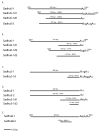The structure, organization and radiation of Sadhu non-long terminal repeat retroelements in Arabidopsis species
- PMID: 20226007
- PMCID: PMC2848041
- DOI: 10.1186/1759-8753-1-10
The structure, organization and radiation of Sadhu non-long terminal repeat retroelements in Arabidopsis species
Abstract
Background: Sadhu elements are non-autonomous retroposons first recognized in Arabidopsis thaliana. There is a wide degree of divergence among different elements, suggesting that these sequences are ancient in origin. Here we report the results of several lines of investigation into the genomic organization and evolutionary history of this element family.
Results: We present a classification scheme for Sadhu elements in A. thaliana, describing derivative elements related to the full-length elements we reported previously. We characterized Sadhu5 elements in a set of A. thaliana strains in order to trace the history of radiation in this subfamily. Sequences surrounding the target sites of different Sadhu insertions are consistent with mobilization by LINE retroelements. Finally, we identified Sadhu elements grouping into distinct subfamilies in two related species, Arabidopsis arenosa and Arabidopsis lyrata.
Conclusions: Our analyses suggest that the Sadhu retroelement family has undergone target primed reverse transcription-driven retrotransposition during the divergence of different A. thaliana strains. In addition, Sadhu elements can be found at moderate copy number in three distinct Arabidopsis species, indicating that the evolutionary history of these sequences can be traced back at least several millions of years.
Figures





Similar articles
-
Meiotically stable natural epialleles of Sadhu, a novel Arabidopsis retroposon.PLoS Genet. 2006 Mar;2(3):e36. doi: 10.1371/journal.pgen.0020036. Epub 2006 Mar 17. PLoS Genet. 2006. PMID: 16552445 Free PMC article.
-
Differential epigenetic regulation within an Arabidopsis retroposon family.Genetics. 2007 May;176(1):151-60. doi: 10.1534/genetics.107.071092. Epub 2007 Mar 4. Genetics. 2007. PMID: 17339215 Free PMC article.
-
The evolutionary origin and genomic organization of SINEs in Arabidopsis thaliana.Mol Biol Evol. 2001 Dec;18(12):2315-22. doi: 10.1093/oxfordjournals.molbev.a003778. Mol Biol Evol. 2001. PMID: 11719581
-
DIRS-1 and the other tyrosine recombinase retrotransposons.Cytogenet Genome Res. 2005;110(1-4):575-88. doi: 10.1159/000084991. Cytogenet Genome Res. 2005. PMID: 16093711 Review.
-
Apolipoprotein B mRNA-editing, catalytic polypeptide cytidine deaminases and retroviral restriction.Wiley Interdiscip Rev RNA. 2012 Jul-Aug;3(4):529-41. doi: 10.1002/wrna.1117. Epub 2012 Apr 30. Wiley Interdiscip Rev RNA. 2012. PMID: 22549984 Review.
Cited by
-
Robustness of Transposable Element Regulation but No Genomic Shock Observed in Interspecific Arabidopsis Hybrids.Genome Biol Evol. 2018 Jun 1;10(6):1403-1415. doi: 10.1093/gbe/evy095. Genome Biol Evol. 2018. PMID: 29788048 Free PMC article.
-
Active transposition in genomes.Annu Rev Genet. 2012;46:651-75. doi: 10.1146/annurev-genet-110711-155616. Annu Rev Genet. 2012. PMID: 23145912 Free PMC article. Review.
-
Control of Cognate Sense mRNA Translation by cis-Natural Antisense RNAs.Plant Physiol. 2019 May;180(1):305-322. doi: 10.1104/pp.19.00043. Epub 2019 Feb 13. Plant Physiol. 2019. PMID: 30760640 Free PMC article.
References
-
- Santi L, Wang Y, Stile MR, Berendzen K, Wanke D, Roig C, Pozzi C, Müller K, Müller J, Rohde W, Salamini F. The GA octodinucleotide repeat binding factor BBR participates in the transcriptional regulation of the homeobox gene Bkn3. Plant J. 2003;34:813–826. doi: 10.1046/j.1365-313X.2003.01767.x. - DOI - PubMed
LinkOut - more resources
Full Text Sources
Molecular Biology Databases

